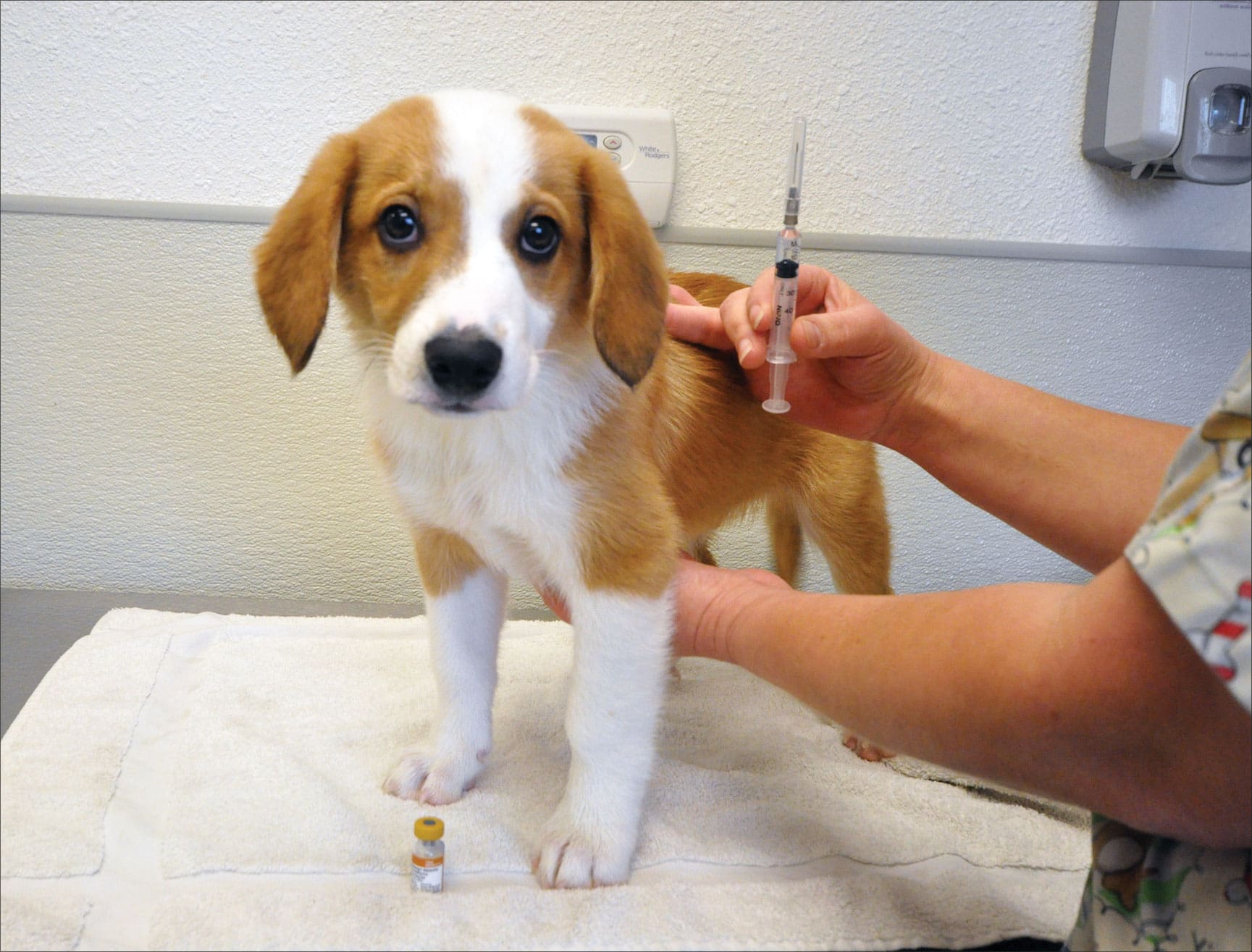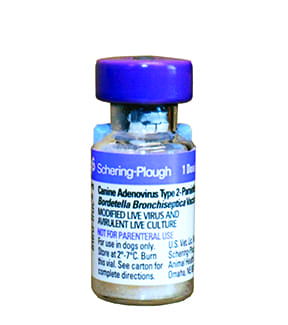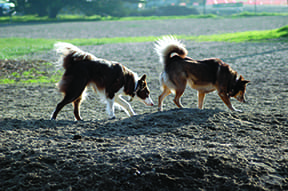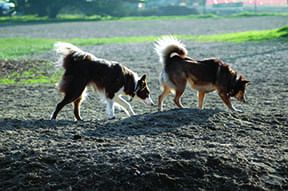It’s baaaaack. News that infectious canine hepatitis surfaced in New England this summer is not exactly on par with the possessed television sets and otherworldly bedroom-closet portals in the 1980s horror flick “Poltergeist.” But the fact that the disease – formally known as canine adenovirus-1, or CAV-1 – has materialized in the United States is likely to induce goosebumps in those who have opted to not vaccinate against it, thinking it was essentially obliterated in the American dog population.

288
And for a long while, it probably was. While commonplace in the early to mid-20th century, this virus – which attacks the liver and kidneys – had been rare for decades in the United States. Indeed, it is highly unlikely that most middle-aged veterinarians have ever encountered the disease, making its reappearance all the more problematic in terms of being correctly diagnosed.
Epidemiologists have long known that infectious canine hepatitis persists in the Mexican dog population, and about a decade ago, there were several confirmed cases in San Diego, California, believed to have originated from dogs brought across the border. The disease is also known to exist among wild canids in Canada, and the November 2012 issue of the Canadian Veterinary Journal cited a case of an 11-week-old Alaskan Husky who had been kept outdoors in the Yukon, where infectious canine hepatitis is considered endemic in the wildlife; on postmortem, the puppy tested positive for CAV-1. As for this summer’s New England outbreak, the prime suspect was a red fox, which presumably brought the disease from the north.
Catherine Ford of Omega Rhodesian Ridgebacks in Brookline, New Hampshire, believes her two 3½-month-old puppies contracted infectious canine hepatitis while attending a puppy party at a Massachusetts farm this August. Eight of Ford’s puppies from that litter attended the party; four had been vaccinated for canine hepatitis, and four had not. Two of the unvaccinated puppies – Ford’s pick of the litter, Zima, and her brother Dhahabu, who went to his new home soon after – became symptomatic three weeks after romping in the farm fields.
Symptoms of infectious canine hepatitis include fever, listlessness, and loss of appetite. When Zima started to refuse food, Ford’s vet thought it was a reaction to the antibiotics she had been given for a suspected urinary tract infection. When Zima worsened, the vet was concerned that she might have leptospirosis, and even suggested her illness might be a result of being raw-fed. By the time Ford took her to an emergency clinic at 1 a.m., Zima was beyond hope.
“It was very fast – 24 hours from ‘I don’t want to eat my breakfast’ to dead,” Ford says. “Before that, the puppies played, they ate, they were acting normally. That was what was so incredibly difficult to accept.”
Titers showed antibodies to CAV-1, and a necropsy confirmed the diagnosis. That left Ford – whose puppy vaccination protocol did not include canine adenovirus – to scramble.
“I’m in a precarious position with all my dogs,” she says. “When we got the diagnosis, we brought all our dogs in to get vaccinated.” A year-and-a-half-old dog who lives nearby and spent some time with Zima when she was incubating the virus is not symptomatic, but urinalysis showed he is shedding the virus. That means he was infected by canine hepatitis, but survived it, and his kidneys could continue to shed the virus for up to six months.
The Disease
Ronald Schultz, PhD, Diplomate ACVIM (American College of Veterinary Internal Medicine), is professor and chair of the Department of Pathobiological Sciences at the University of Wisconsin-Madison School of Veterinary Medicine. He’s also the person who confirmed Zima’s cause of death. Dr. Schultz thinks this canine hepatitis outbreak is a very valid concern.

288
“This is the reason I’ve tried to really emphasize the importance of canine adenovirus being a core vaccine, because we have the disease in Mexico, and we know we have the disease in wildlife species in Canada,” he says. “If it’s in the wildlife in Massachusetts, then unfortunately it’s probably elsewhere.” Any wild canid (such as coyotes), or mink, skunk, raccoon, fox, or bear could transmit the disease. “We do have a lot of potential wildlife reservoirs – something we have to be concerned about.”
Dr. Schultz says it is difficult to determine how many cases have gone unrecognized.
“There are many vets who wouldn’t recognize a case,” he says, adding that when he lectures to veterinarians, he asks how many have seen a patient with infectious canine hepatitis, or think they could recognize one. “It would be the gray hairs like me – or no hairs at all – who raise their hands.”
Because the disease is so rare in the American domestic dog population, many vets simply don’t have it on their radar screens. “When you’re looking for something and you know what it is, you find it,” Dr. Schultz says. But with canine hepatitis, “we’ve pretty much come to the conclusion that it couldn’t be that. That’s just human nature. I think there could have been some cases that have been missed, no question about it.”
Dr. Schultz describes infectious canine hepatitis as “just as virulent as parvovirus or canine distemper,” and notes that it causes some similar clinical signs. It is up to 50 percent fatal in puppies under five months of age, and will also infect and cause disease in older dogs who are susceptible. “This virus is very stable in the environment, but not as stable as parovirus,” he says. “When it infects, it has the ability to remain persistent and be shed in urine for months.”
Like parvovirus and distemper, canine hepatitis can be supported with intervention and palliative care like intravenous fluids for hydration. But unlike parvovirus, which affects the intestinal tract, canine hepatitis devastates the kidneys and liver, which, once damaged, severely curtail survivability.
Vaccination Picture
There are two strains of adenovirus that are a concern in dogs. Canine adenovirus type 1, or CAV-1, produces the infectious canine hepatitis described in this article. The other, CAV-2, affects the respiratory system and is a common cause of kennel cough. A vaccine for CAV-1 fell out of use in the 1970s because one out of 500 vaccinated dogs developed “blue eye,” an occular discoloration that resulted from a hypersensitivity to the vaccine. Today, the CAV-2 vaccine is used instead of CAV-1 because it is closely enough related to CAV-1 to cross-protect against it, and it does not produce this side effect.
In its 2011 revised canine vaccine guidelines, the American Animal Hospital Association (AAHA) classifies CAV-2 as a “core” vaccine, or one for which every dog should be vaccinated.
“Puppies should be vaccinated every 3 to 4 weeks between the ages of 6 and 16 weeks (e.g., at 6, 10, and 14 weeks, or 8, 12, and 16 weeks),” the guidelines say, although they go on to note that “one dose is considered protective and acceptable,” provided that there is no interfering maternal immunity.
To minimize this risk of maternal antibody interference with vaccination, the AAHA guidelines say the final dose of the initial series should be administered between 14 and 16 weeks of age.
AAHA recommends that a booster be given no later than one year after the completion of the initial puppy series.
Beyond that, AAHA recommends that dogs be revaccinated every three years, although it notes that “among healthy dogs, all commercially available MLV CAV-2 vaccines are expected to induce a sustained protective immune response lasting at least seven years.”
Dr. Schultz thinks dogs should be vaccinated according to the AAHA guidelines, which he helped draft. But other experts have reservations about giving the three-way parvovirus/distemper/adenovirus vaccine to young puppies.
Many holistic-minded dog owners follow the minimal vaccination protocol recommended by well-known veterinary hematology and vaccine expert W. Jean Dodds, DVM, which excludes the CAV-2 vaccine. In light of the disease’s reappearance, Dr. Dodds says she has been mulling over what the appropriate response should be. For the moment, she has not changed her protocol, other than to note that there has been a clinical outbreak of the disease in the Northeast, and that owners in that part of the country might factor the outbreak into their decision-making.
Dr. Dodds is reluctant to start reflexively recommending a three-way vaccine because when the CAV-2 vaccine is administered to puppies at the same time as the distemper vaccine, and both vaccine viruses replicate in the body simultaneously, immunosuppression can occur. This hiccup of the immune system starts about three days after vaccination and can continue for up to 10 days afterward. For that week-long span, the puppy is immunologically vulnerable, with a compromised immune system.
“This immunosuppressive effect does not occur when adult dogs are vaccinated with CAV-2,” Dr. Dodds says, because by then the dog likely has immunity to distemper, and both vaccine viruses must be replicating at the same time for the immunosuppression to occur. One option she is considering is giving CAV-2 at the one-year mark, in two doses three weeks apart.
This, however, does not protect puppies from canine hepatitis. For his part, Dr. Schultz thinks the risks of immunosuppression are minimal. “If those puppies are not in an [at-risk] environment like a shelter” – or they don’t already have a disease such as pyoderma or demodectic mange – the immunosuppression goes unnoticed, he says. “It is transient, and only occurs when an animal has no interfering antibodies to one or the other, so both viruses replicate together. It doesn’t lead to clinically significant events in the majority of dogs.”
Dr. Dodds counters that cases of immunosuppression from vaccination can go unreported and undiagnosed, just as many vaccine reactions do. “If you asked 100 vets if they’ve seen a vaccine reaction, maybe one would say yes, when we know it is much more,” she says, stressing that the same could be true of awareness of vaccine-induced immunosuppression. She adds that the immunosuppression risk occurs at a time when puppies are particularly vulnerable. “If you take tissue immunity and you suppress it for 10 days at a time when the animal is undergoing new stresses – new home, new food, new everything – it sets the animal up to be susceptible to other stressors,” she says. “This is a critical period, in my view.”
Other Options
For puppies, the best option, of course, would simply be to vaccinate with CAV-2 some time after a parvovirus-distemper vaccination is administered. The problem? A single CAV-2 vaccine is not commercially available, and likely won’t be.
Dr. Schultz notes that there are several ways to get around the immunosuppression problem created when the adenovirus and distemper vaccine viruses are replicating at the same time. None is perfect, and owners will have to consider their individual animals and their risk factors before arriving at a decision that is best for them.
Options include:
– Give a bivalent (two-way) vaccine containing parvo-virus and distemper, and then give the CAV-2 vaccine intranasally.

288
Since CAV-2 is part of the kennel-cough complex, it is available as an intransal vaccine along with B bronchiseptica (Bb) and canine parainfluena (CPI). Because it triggers a different immune response, the intranasal vaccine does not cause immunosuppression, Dr. Schultz says, even if the distemper/parvovirus vaccine is injected at the same time.
Dr. Schultz says he has recommended this approach to those who have administered the distemper/parvovirus vaccine because he was always concerned about susceptibility to adenovirus. “I generally like to wait until after the last dose with distemper-parvovirus, which is 14 to 16 weeks.” He adds that CAV-2 can cause severe respiratory disease, and is worth vaccinating against in its own right.
Downside: Many vets dislike administering the intranasal vaccine, as many dogs don’t find having liquid shot up their noses to be particularly pleasurable. Also, because many vets routinely give three-way vaccines that contain CAV-2, the intranasal vaccine they stock more than likely does not contain it.
– Give an initial parvovirus-distemper vaccine, then administer a three-way vaccine containing CAV-2 once the dog has developed immunity to distemper.
The trick with this approach is determining when the dog has mounted immunity to distemper. Both Drs. Dodds and Schultz recommend waiting until 12 to 16 weeks, a time when distemper immunity has been achieved by the majority of puppies.
Dr. Schultz says once immunity to distemper has been demonstrated after vaccination by a simple titer, or blood test, then the dog could receive the three-way vaccine. “The dog isn’t going to get immunosuppression because he has already developed distemper immunity,” he explains.
Dr. Dodds sees two possibilities for adapting her vaccine protocol to encompass infectious canine hepatitis without risking immunosuppression: Give a two-way vaccine (parvovirus-distemper) at 9 and 14 weeks, then give the first three-way vaccine containing canine hepatitis at 17 weeks, with a final dose at 24 weeks. Or give the two-way at 9 weeks and 12 weeks, and then give the three-way at 15 and 18 weeks.

288
Both scenarios not only try to avoid immunosuppression, but also seek to give parvovirus at or shortly after 14 weeks, as studies show that many puppies are not protected against parvovirus before that age, despite having been vaccinated for it.
Downside: Waiting until the third installment of the initial vaccine series leaves the puppy susceptible to infectious canine hepatitis in the interim.
– Administer a recombinant three-way vaccine, as opposed to a modified live-virus, or MLV, vaccine.
A recombinant vaccine is sort of a middle ground between a MLV vaccine, which replicates a milder form of the disease in the dog, and a killed vaccine, which doesn’t cause any disease in the dog but which contains preservatives called adjuvants, thought to trigger adverse reactions in some dogs. A recombinant vaccine does not cause immunosuppression when distemper and canine hepatitis are administered together.
“A recombinant vaccine is as efficacious as a MLV vaccine, and as safe as a killed vaccine,” Dr. Schultz says, noting that the Recombitek C3 vaccine contains parovirus, distemper, and adenovirus. In addition to not causing immunosuppression, Dr. Schultz says the vaccine’s distemper component “will immunize at an earlier age than any MLV distemper vaccines.”
That said, Dr. Schultz notes that the three-way recombinant vaccine does not immunize for parvovirus quite as early as some of the other MLV vaccines, so it is not suitable for puppies that are at high risk for exposure to that disease. One option, he says, “is to do a recombinant vaccine at six or eight weeks or whenever you start, then follow up with a traditional MLV combination that contains adenovirus as well as parvovirus.” Because distemper immunity will likely be achieved, “that adenovirus is going to replicate alone, so you won’t get suppression, and that parvovirus will very likely induce immunity.”
Downside: The less effective parvo-virus response is a concern for those with dogs from high-risk parvovirus environment such as shelters. Also, many vets do not normally stock the recombinant vaccine.
In the end, there is no perfect solution. “People need to choose the devil that they prefer,” Dr. Dodds says. “One hundred times they might be fine – and then one time they might not.”
The Good News
If you have never vaccinated your adult dog for canine hepatitis, the first thing is not to panic. The good news is that many dogs, especially those who have been exposed to many other dogs, are probably already immune.
“Once a dog gets out with other dogs, it’s not uncommon for CAV-2 to naturally infect and immunize without causing disease,” explains Dr. Schultz, referring to the respiratory form of the virus. Because CAV-2 immunity also covers CAV-1, those dogs are naturally protected against both. “There is a great deal of natural immunization that has gone on.”
For example, show dogs who are not vaccinated for CAV-1 will very likely become naturally immunized against it when CAV-2 infects them, as respiratory viruses are common in that kind of environment. (Indeed, many consider a case of kennel cough contracted at a show or other doggie event to be the equivalent of the old-fashioned “chicken-pox party” – catch it on purpose and become immune.)
Similarly, if a stray dog comes in contact with canine hepatitis at a shelter, “many of those already came across CAV-2 and are already immune, where they might not be immune to, say, parvovirus,” Dr. Schultz explains.
The “best bet,” he says, if dogs have not been given a CAV-2 vaccine, is to have them titered to see if they have immunity to CAV-1, and to vaccinate if they do not.
Dr. Schultz points out that while renewed concern about canine hepatitis is important in light of these outbreaks, other diseases still pose an arguably greater threat. “I think I’d like my protection against parvovirus, considering how stable and resistant it is in the environment,” he says. “It is in every state in the United States. Some shelters all over the country have parvovirus cases constantly – and the same thing with distemper.”
In short, while the recent news about canine hepatitis should be cause for concern, there is no reason to panic. Even with the documented outbreak this summer, Dr. Schultz doesn’t think the disease will become prevalent, because of the one-two punch of natural and artificial immunity that is already working in the American dog population – and has been for many, many years.
“We’ve got a little bit of nature on our side, and a little bit of vaccine on our side,” he concludes. And, hopefully, that should keep this scary movie from turning into a multi-sequel blockbuster.
Denise Flaim of Revodana Ridgebacks in Long Island, New York, shares her home with a trio of Ridgebacks, three 8-year-olds, and a very patient husband.






